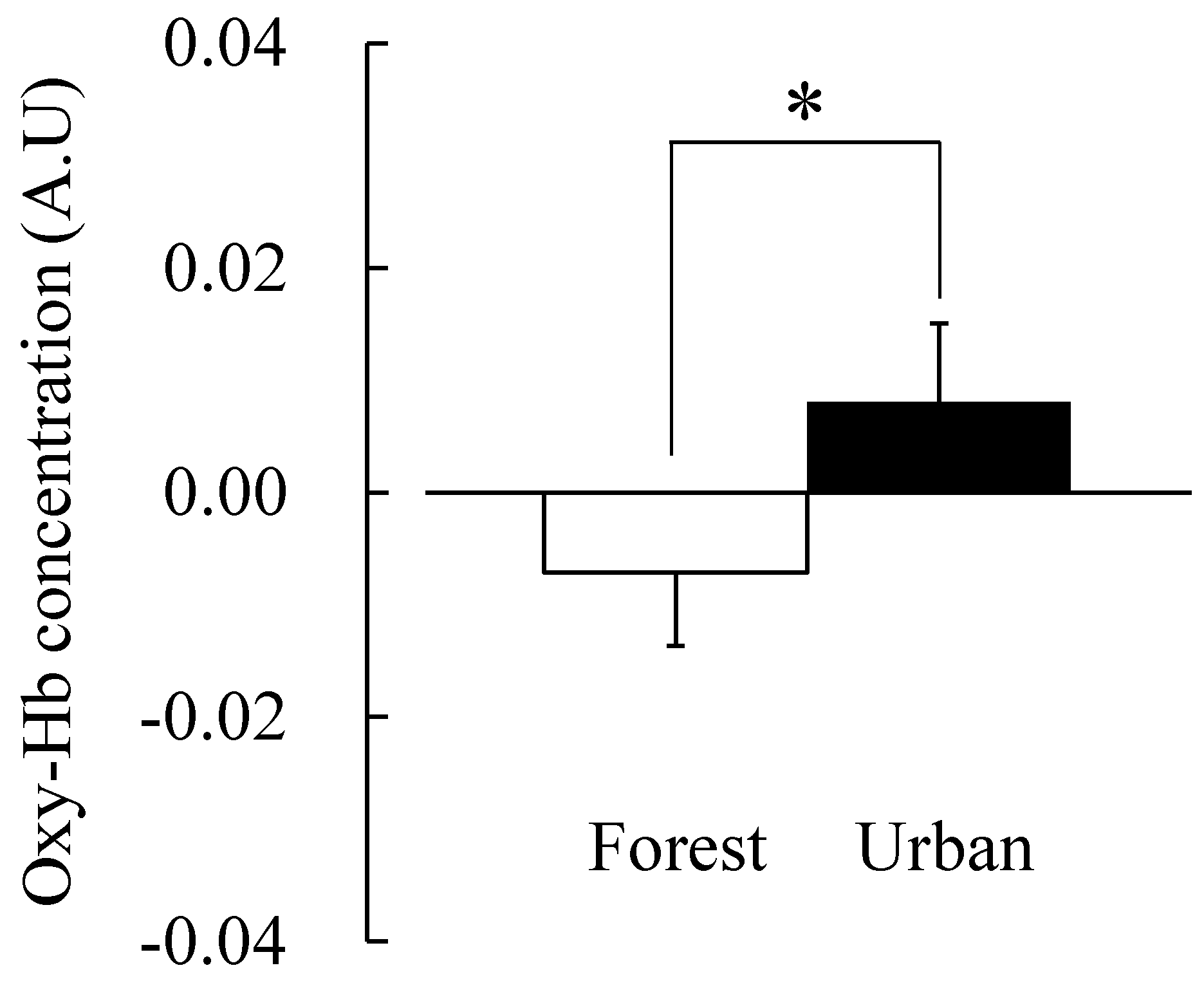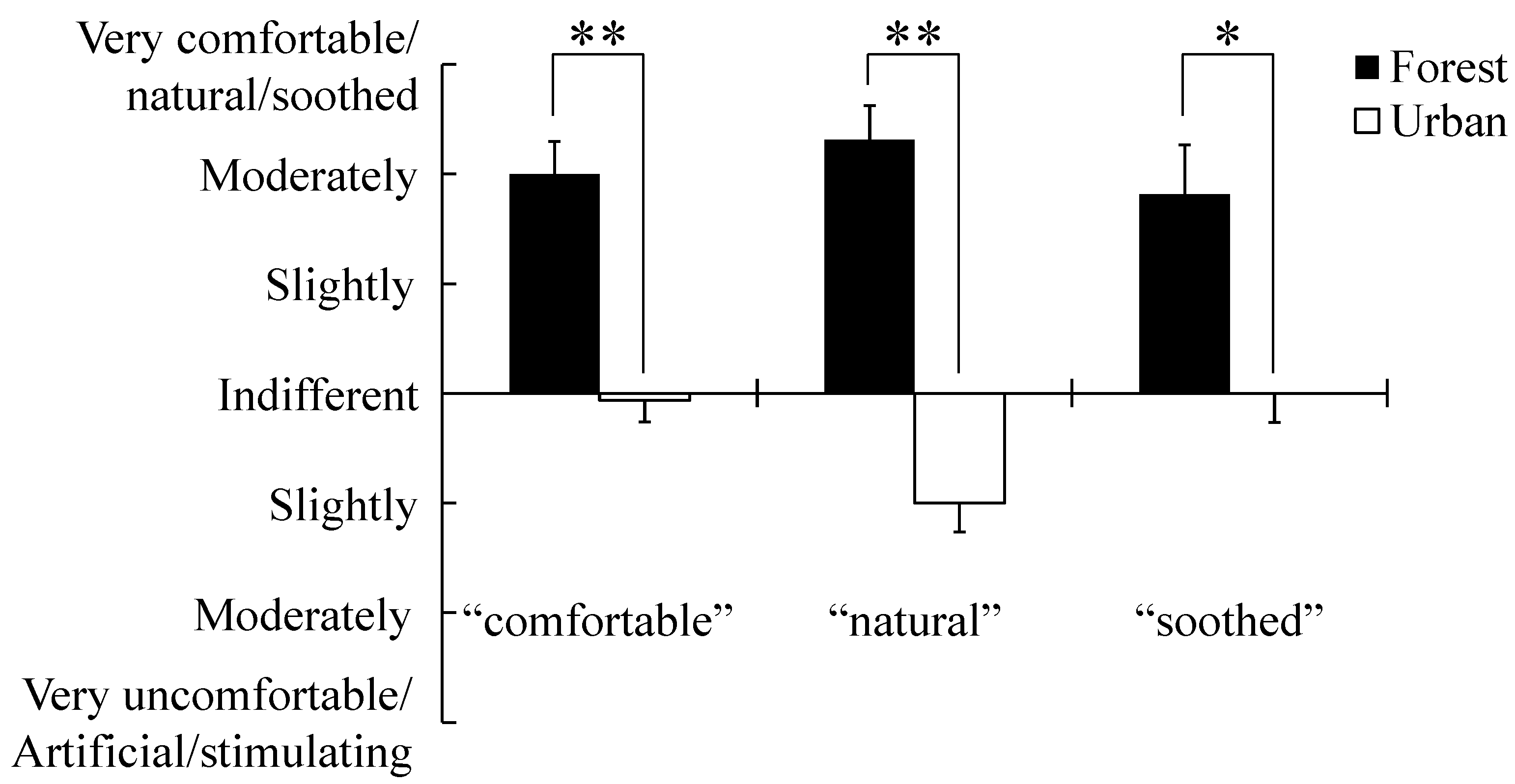The Prefrontal Cortex Activity and Psychological Effects of Viewing Forest Landscapes in Autumn Season
Abstract
:1. Introduction
2. Methods

3. Results and Discussion


| Total Hb | Oxy-Hb | |
|---|---|---|
| Forest area | −0.014 ± 0.007 | −0.007 ± 0.007 |
| Urban area | 0.006 ± 0.006 | 0.008 ± 0.007 |
| p-value | 0.023 * | 0.014 * |


| Comfortable | Natural | Soothed | |
|---|---|---|---|
| Forest area | 4.00 ± 0.60 | 4.63 ± 0.63 | 3.63 ± 0.91 |
| Urban area | 0.13 ± 0.40 | −2.00 ± 0.53 | 0.00 ± 0.53 |
| p-value | 0.006 ** | 0.006 ** | 0.010 * |
| T-A | D | V | F | C | A-H | TMD | |
|---|---|---|---|---|---|---|---|
| Forest area | 0.63 ± 0.38 | 0.13 ± 0.13 | 6.88 ± 2.29 | 2.00 ± 0.53 | 1.63 ± 0.65 | 0.00 ± 0.00 | −2.50 ± 1.49 |
| Urban area | 2.25 ± 0.73 | 0.25 ± 0.25 | 0.63 ± 0.32 | 6.00 ± 1.34 | 1.13 ± 0.30 | 0.63 ± 0.26 | 9.63 ± 0.91 |
| p-value | 0.062 | 0.327 | 0.014 * | 0.021 * | 0.248 | 0.029 * | 0.006 ** |
4. Conclusions
Acknowledgments
Author Contributions
Conflicts of Interest
References
- Park, B.J.; Tsunetsugu, Y.; Kasetani, T.; Morikawa, T.; Kagawa, T.; Miyazaki, Y. Physiological effects of forest recreation in a young conifer forest in Hinokage town, Japan. Silva Fenn. 2009, 43, 291–301. [Google Scholar] [CrossRef]
- Tsunetsugu, Y.; Park, B.J.; Ishii, H.; Hirano, H.; Kagawa, T.; Miyazaki, Y. Physiological effects of shinrin-yoku (taking in the atmosphere of the forest) in an old-growth broadleaf forest in Yamagata prefecture, Japan. J. Physiol. Anthropol. 2007, 26, 135–142. [Google Scholar] [CrossRef] [PubMed]
- Park, B.J.; Tsunetsugu, Y.; Kasetani, T.; Kagawa, T.; Miyazaki, Y. The physiological effects of Shinrin-yoku (taking in the forest atmosphere of forest bathing): Evidence from field experiments in 24 forests across Japan. Environ. Health Prev. Med. 2010, 15, 18–26. [Google Scholar] [CrossRef] [PubMed]
- Park, B.J.; Tsunetsugu, Y.; Ishii, H.; Furuhashi, S.; Hirano, H.; Kagawa, T.; Miyazaki, Y. Physiological effects of Shinrin-yoku (taking in the atmosphere of the forest) in a mixed forest in Shinano Town, Japan. Scand. J. For. Res. 2008, 23, 278–283. [Google Scholar] [CrossRef]
- Lee, J.; Tsunetsugu, Y.; Takayama, N.; Park, B.J.; Li, Q.; Song, C.; Komatsu, M.; Ikei, H.; Tyrväinen, L.; Kagawa, T.; et al. Influence of forest therapy on cardiovascular relaxation in young adults. Evid.-Based Complement. Altern. Med. 2014. [Google Scholar] [CrossRef]
- Lee, J.; Park, B.J.; Tsunetsugu, Y.; Ohira, T.; Kagawa, T.; Miyazaki, Y. Effect of forest bathing on physiological and psychological responses in young Japanese male subjects. Public Health 2011, 125, 93–100. [Google Scholar] [CrossRef] [PubMed]
- Lee, J.; Park, B.J.; Tsunetsugu, Y.; Kagawa, T.; Miyazaki, Y. Restorative effects of viewing real forest landscapes, based on a comparison with urban landscapes. Scand. J. For. Res. 2009, 24, 227–234. [Google Scholar] [CrossRef]
- Park, B.J.; Tsunetsugu, Y.; Kasetani, T.; Hirano, H.; Kagawa, T.; Sato, M.; Miyazaki, Y. Physiological effects of Shinrin-yoku (Taking in the atmosphere of the forest)-using salivary cortisol and cerebral activity as indicators. J. Physiol. Anthropol. 2007, 26, 123–128. [Google Scholar] [CrossRef] [PubMed]
- Li, Q.; Morimoto, K.; Kobayashi, M.; Inagaki, H.; Katsumata, M.; Hirata, Y.; Hirata, K.; Suzuki, H.; Li, Y.J.; Wakayama, Y.; et al. Visiting a forest, but not a city, increases human natural killer activity and expression of anti-cancer proteins. Int. J. Immunopathol. Pharmacol. 2008, 21, 117–127. [Google Scholar] [PubMed]
- Li, Q.; Morimoto, K.; Kobayashi, M.; Inagaki, H.; Katsumata, M.; Hirata, Y.; Hirata, K.; Shimizu, T.; Li, Y.J.; Wakayama, Y.; et al. A forest bathing trip increases human natural killer activity and expression of anti-cancer proteins in female subjects. J. Biol. Regul. Homeost. Agents 2008, 22, 45–55. [Google Scholar] [PubMed]
- Tsunetsugu, Y.; Park, B.J.; Miyazaki, Y. Trends in research related to “Shinrin-yoku” (taking in the forest atmosphere of forest bathing) in Japan. Environ. Health Prev. Med. 2010, 15, 27–37. [Google Scholar] [CrossRef] [PubMed]
- Wang, J.; Rao, H.; Wetmore, G.S.; Furlan, P.M.; Korczykowski, M.; Dinges, D.F. Perfusion functional MRI reveals cerebral blood flow pattern under psychological stress. Proc. Natl. Acad. Sci. USA 2005, 102, 17804–17809. [Google Scholar] [CrossRef] [PubMed]
- Tanida, M.; Sakatani, K.; Takano, R.; Tagai, K. Relation between asymmetry of prefrontal cortex activities and the autonomic nervous system during a mental arithmetic task: Near infrared spectroscopy study. Neurosci. Lett. 2004, 369, 69–74. [Google Scholar] [CrossRef] [PubMed]
- Tanida, M.; Katsuyama, M.; Sakatani, K. Effect of fragrance administration on stress-induced prefrontal cortex activity and sebum secretion in the facial skin. Neurosci. Lett. 2008, 432, 157–161. [Google Scholar] [CrossRef] [PubMed]
- Jobsis, F.F. Noninvasive, infrared monitoring of cerebral and myocardial oxygen sufficiency and circulatory parameters. Science 1977, 198, 264–1267. [Google Scholar] [CrossRef]
- Mizuno, T.; Watanabe, T.; Iwai, H.; Shikayama, T.; Miwa, M.; Yamashita, Y.; Eda, H. High-speed sampling measurements of tissue oxygenation by the portable near-infrared monitoring system. Iryo kikigaku 2010, 80, 189–195. (in Japanese). [Google Scholar] [CrossRef]
- Ikei, H.; Komatsu, M.; Song, C.; Aga, M.; Igarashi, M.; Lee, J.; Lee, S.; Kagawa, T.; Kobayashi, H.; Miyazaki, Y. Effect of forest therapy on prefrontal cortex activity-using portable NIRS. In The Report at 67th Conference of the Japan Society of Physiological Anthropology (JSPA), Tokyo, Japan, 17–18 November 2012; Paper No. 01–1; JSPA: Tokyo, Japan, 2012; pp. 34–35. (in Japanese) [Google Scholar]
- Delpy, D.T.; Cope, M.; Zee, P.; Arridge, S.; Wray, S.; Wyatt, J. Estimation of optical pathlength through tissue from direct time of flight measurement. Phys. Med. Biol. 1988, 33, 1433–1442. [Google Scholar] [CrossRef] [PubMed]
- Osgood, C.E.; Suci, G.J.; Tannenbaum, P. The Measurement of Meaning; University of Illinois Press: Urbana, IL, USA, 1957. [Google Scholar]
- McNair, D.; Lorr, M. An analysis of mood in neurotics. J. Abnorm. Soc. Psychol. 1964, 69, 620–627. [Google Scholar] [CrossRef]
- Kim, E.J.; Lee, S.I.; Jeong, D.U.; Shin, M.S.; Yoon, I.Y. Standardization and reliability and validity of the Korean edition of profile of mood states (K-POMS). Sleep Med. Psychophysiol. 2003, 10, 39–51. [Google Scholar]
- McNari, D.; Lorr, M.; Droppleman, L. Manual for the Profile of Mood States; Educational and Industrial Testing Services: San Diego, CA, USA, 1971. [Google Scholar]
- Bausell, R.B. The Design and Conduct of Meaningful Experiments Involving Human Participants; Oxford University Press: New York, NY, USA, 2015. [Google Scholar]
- Park, B.J.; Furuya, K.; Kasetani, T.; Takayama, N.; Kagawa, T.; Miyazaki, Y. Relationship between psychological responses and physical environments in forest settings. Landsc. Urban Plan. 2011, 102, 24–32. [Google Scholar] [CrossRef]
- Tsunetsugu, Y.; Lee, J.; Park, B.J.; Tyrvainen, L.; Kagawa, T.; Miyazaki, Y. Physiological and psychological effects of viewing urban forest landscapes assessed by multiple measurement. Landsc. Urban Plan. 2013, 113, 90–93. [Google Scholar] [CrossRef]
© 2015 by the authors; licensee MDPI, Basel, Switzerland. This article is an open access article distributed under the terms and conditions of the Creative Commons Attribution license (http://creativecommons.org/licenses/by/4.0/).
Share and Cite
Joung, D.; Kim, G.; Choi, Y.; Lim, H.; Park, S.; Woo, J.-M.; Park, B.-J. The Prefrontal Cortex Activity and Psychological Effects of Viewing Forest Landscapes in Autumn Season. Int. J. Environ. Res. Public Health 2015, 12, 7235-7243. https://doi.org/10.3390/ijerph120707235
Joung D, Kim G, Choi Y, Lim H, Park S, Woo J-M, Park B-J. The Prefrontal Cortex Activity and Psychological Effects of Viewing Forest Landscapes in Autumn Season. International Journal of Environmental Research and Public Health. 2015; 12(7):7235-7243. https://doi.org/10.3390/ijerph120707235
Chicago/Turabian StyleJoung, Dawou, Geonwoo Kim, Yoonho Choi, HyoJin Lim, Soonjoo Park, Jong-Min Woo, and Bum-Jin Park. 2015. "The Prefrontal Cortex Activity and Psychological Effects of Viewing Forest Landscapes in Autumn Season" International Journal of Environmental Research and Public Health 12, no. 7: 7235-7243. https://doi.org/10.3390/ijerph120707235






